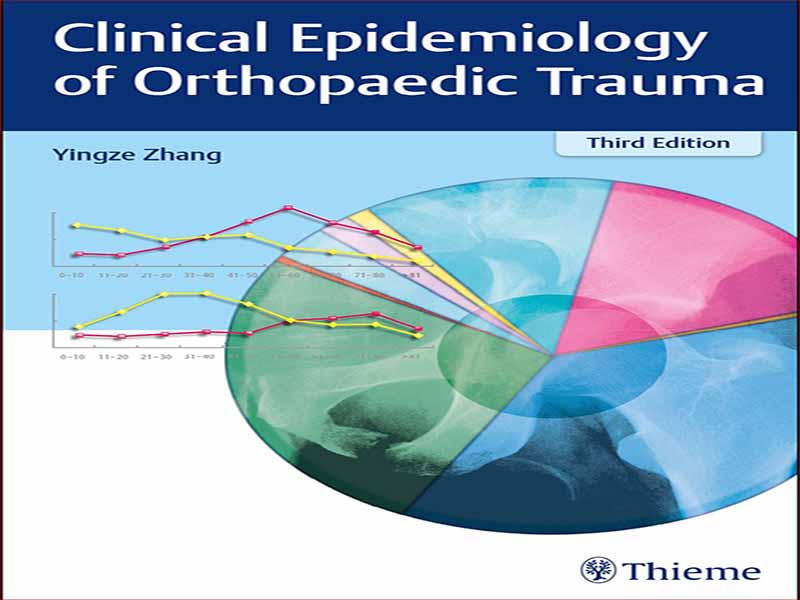- عنوان کتاب: Clinical Epidemiology of Orthopaedic Trauma
- نویسنده: Yingze Zhang
- حوزه: ارتوپدی
- سال انتشار: 2022
- تعداد صفحه: 821
- زبان اصلی: انگلیسی
- نوع فایل: pdf
- حجم فایل: 21.5 مگابایت
این کتاب، اپیدمیولوژی بالینی ترومای ارتوپدی، اولین تک نگاری اپیدمیولوژی شکستگی است. اولین نسخه توسط Publishing House People’s Medical در سال 2009 منتشر شد و توسط Thieme Medical Publishers به انگلیسی ترجمه شد و در سال 2012 در سراسر جهان توزیع شد. پروفسور دیوید ای. پارکر از کارولینای شمالی نقدی بر این کتاب نوشت و آن را کتاب درسی عالی با ساختار معقول، تصاویر و تصاویر فراوان و توضیحات مختصر دانست. نسخه اول بر اساس بررسی گذشته نگر 60266 بیمار (65267 شکستگی) بود که در یک دوره 5 ساله از سال 2003 تا 2007 در مرکز ترومای ما تحت درمان قرار گرفتند. مطالعه چند مرکزی برای به دست آوردن درک جامعی از ویژگی اپیدمیولوژی ترومای ارتوپدی. بر اساس ویرایش اول، یک تحقیق پیشرفته در سراسر کشور انجام شد. در سراسر کشور، 83 بیمارستان از 31 استان با روش نمونهگیری تصادفی طبقهای چندمرحلهای انتخاب و 414835 بیمار (431822 شکستگی) از تمام سطوح مرکز تروما شناسایی و وارد مطالعه شدند. تیم های تحقیقاتی ما متشکل از جراحان ارتوپد، رادیولوژیست ها و اپیدمیولوژیست ها هستند. فرم های نظرسنجی و طرح جمع آوری و تجزیه و تحلیل داده ها با جزئیات طراحی شد. همه محققان برای طبقه بندی شکستگی ها به طور دقیق و پیوسته آموزش دیده بودند. طبقه بندی AO در این نسخه پذیرفته شد، زیرا به دلیل عملی بودن، یکنواختی و قابل مقایسه بودن آن به طور گسترده در سراسر جهان شناخته شده بود. در همین حال، طبقهبندیهای خاص شکستگی دیگر برای منعکس کردن ویژگی شکستگی به طور جامع اتخاذ شد. دو جراح ارشد ارتوپد و یک رادیولوژیست مسئول کیفیت بالای کار بودند. ویرایش دوم پس از جمع بندی نتایج تکمیل شد. این سومین ویرایش اپیدمیولوژی بالینی ترومای ارتوپدی، بروز ملی شکستگی های تروماتیک در چین را اضافه می کند. مطالعه شکست ملی چین با استفاده از نمونهگیری تصادفی طبقهای و روش احتمال متناسب با اندازه، نمونهای نماینده ملی از 8 استان، 24 شهر شهری و 24 شهرستان روستایی در چین انتخاب کرد. تحت کنترل کیفیت دقیق، در نهایت 512187 پرسشنامه موثر دریافت شد. ما میزان بروز شکستگیهای تروماتیک را برای کل جمعیت و زیر گروهها بر اساس سن و جنس، و همچنین بر اساس عوامل جمعیت شناختی مانند منشاء قومی، شغل، منطقه جغرافیایی، و دسته محل اقامت تخمین زدیم. این کتاب ویژگی اپیدمیولوژیک انواع مختلف شکستگی را به طور مختصر و در عین حال جامع معرفی می کند. روندها و تغییرات جدید نیز ثبت شد. اگرچه سازمان ساختاری مطابق با آخرین نسخه است، حجم نمونه تا حد زیادی افزایش یافته است تا منعکس کننده روندهای معتبرتر و دقیق تر و تغییرات در ویژگی های اپیدمیولوژیک شکستگی ها در چین به عنوان یک کشور باشد. گرافیک آسان و در عین حال عالی، با فیلم های اشعه ایکس مربوطه و نمودارهای خط شکست حفظ می شود. تصویربرداری تشدید مغناطیسی یا توموگرافی کامپیوتری برای شکستگی های پیچیده اضافه می شود تا به طور کامل ویژگی های آسیب را نشان دهد. به منظور انجام تحقیقات بالینی و علمی، بخشهای «تشخیص» و «درمان» با آخرین پیشرفتها و پیشرفتها بهروز شد. به دلیل حجم زیاد کار و برنامه فشرده، اشتباهات و خطاها اجتناب ناپذیر است. منتظر نظرات و پیشنهادات ارزشمند شما هستیم. که کمک سخاوتمندانه ای به تلاش های ما برای ایجاد یک تک نگاری کامل خواهد بود. همه کسانی که روی این کتاب کار کردهاند دارای سوابق بالینی و تحقیقات علمی هستند. آنها برای این کتاب تلاش زیادی کردند که این انتشار را ممکن کرد. عمیق ترین تشکر و احترام من به همه آنها!
This book, Clinical Epidemiology of Orthopaedic Trauma, is the first monograph on fracture epidemiology. The first edition was published by People’s Medical Publishing House in 2009, and translated into English by Thieme Medical Publishers and distributedworldwide in 2012. The book received extensive positive reviews for its unique writing style, which combined knowledge in both theory and practice. Prof. David E. Parker from North Carolina wrote a review of the book, considering it an excellent textbook with reasonable structure, abundant illustrations and pictures, and concise description. The first edition was based on a retrospective review of 60,266 patients (65,267 fractures) treated at our trauma center over a 5-year period from 2003 to 2007. Given large differences in natural and social environments in China, we performed a large-scale, multicenter study to get a comprehensive understanding of the feature of orthopaedic trauma epidemiology. Based on the first edition, an advanced research throughout the nation was carried out. Across the nation, 83 hospitals from 31 provinces were selected with a stratified multistage random sampling method and 414,835 patients (431,822 fractures) were identified from all levels of trauma center and included in the study. Our research teams comprise of orthopaedic surgeons, radiologists, and epidemiologists. Survey forms and data collection and analysis scheme were designed in detail. All researchers were trained to classify the fractures accurately and consistently. The AO classification was adopted in this edition, as it had been widely recognized worldwide because of its practicality, uniformity, and comparability. Meanwhile, other special fracture classifications were adopted to reflect the feature of fracture comprehensively. Two senior orthopaedic surgeons and one radiologist were responsible for the high quality of the work. The second edition was completed after tallying the results. This third edition of Clinical Epidemiology of Orthopaedic Trauma adds national incidence of traumatic fractures in China. The ChinaNational Fracture Study recruited a nationally representative samplefrom 8 provinces, 24 urban cities, and 24 rural counties in China using stratified random sampling and the probability proportional to size method. Under strict quality control, 512,187 effective questionnaires were got at last. We estimated incidence rates for traumatic fractures for the overall population and for subgroups by age and sex, as well as by demographic factors such as ethnic origin, occupation, geographical region, and residency category. This book introduces the epidemiological feature of individual types of fracture concisely and yet comprehensively. The new trends and changes were documented as well. Although the structural organization is consistent with the last edition, the sample size is increased largely to reflect more authentic and accurate trends and changes in the epidemiological features of fractures in China as a nation. The easy-to-understand yet excellent graphics, with corresponding X-ray films and fracture line graphs are retained. Magnetic resonance imaging or computed tomography images are added for complicated fractures to fully illustrate the characteristics of the injuries. For thepurpose of clinical and scientific research, the sections “Diagnosis” and “Treatment”were updatedwith the latest developments and progress.Omissions and mistakes are unavoidable due to the heavy workload and tight schedule.We are looking forward to your valuable comments and suggestions, which will be a generous help to our endeavors to create a consummate monograph. All those who worked on the book have clinical and scientific research backgrounds. They made great efforts on this book, which made this publication possible. My deepest gratitude and respect to all of them!
این کتاب را میتوانید بصورت رایگان از لینک زیر دانلود نمایید.


































نظرات کاربران